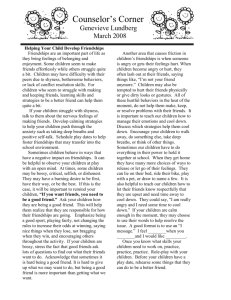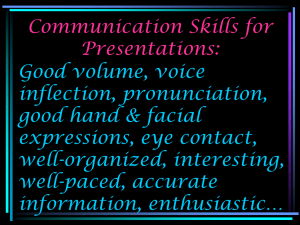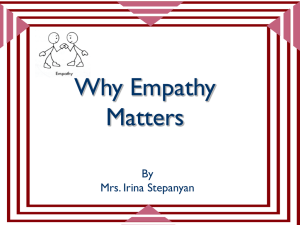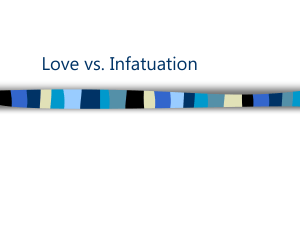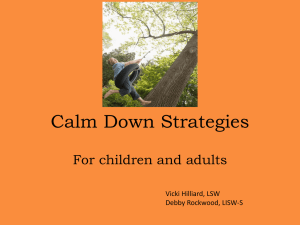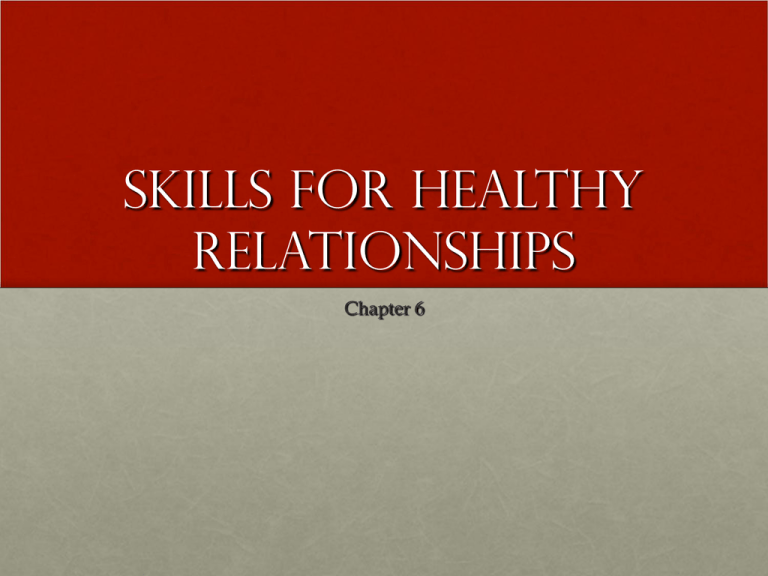
Skills for healthy
relationships
Chapter 6
Effective
communication
• Communication: is the process of sharing
information, thoughts, or feelings
• “I” Messages: a statement that expresses your feelings,
but does not blame or judge the other person
• Example: “I am upset because we didn’t talk last night”
• Active Listening: focusing your full attention on what
the other person is saying and letting that person know
you understand and care
Active Listening
• Looking at the speaker, nodding your head, facial
expressions
• Encourage the speaker to begin. “Do you want to talk
about….”
• Ask questions or state comments when they pause
• Avoid passing judgment
• Summarize the speaker’s ideas with phrases. “I heard you
say…”
• Help speaker explore further. “Tell me more about…”
• Do not steer the conversation away from the speaker’s
problem
Effective
communication cont’d
• Assertiveness:
• Passive: holding back your true feelings and going along
with another person
• Aggressive: communicate opinions and feelings in a way
that may seem threatening or disrespectful to other
people
• Assertive: You are able to stand up for yourself while
expressing your feelings in a way that does not threaten
the other person
Passive Behaviors
• Hoping the other person will guess your feelings
• Always listening, rarely talking
• Denying your own feelings, making excuses
• Criticizing yourself, always apologizing
• Always giving in to other people
• Mumbling, looking away, fidgeting nervously
Aggressive behaviors
• Using “you” messages to blame the other person
• Interrupting, being sarcastic
• Making fun of the other person’s feelings
• Criticizing the other person, never giving a compliment
• Always wanting your way
• Yelling, refusing to talk, finger pointing, glaring, using
physical force
Assertive Behaviors
• Using “I” messages to explain your feelings
• Actively listening to the other person
• Trying to understand the other person’s feelings
• Expressing appreciation, being respectful
• Seeking a compromise that does not go against either
person’s values
• Speaking confidently and clearly, making eye contact,
showing interest
Effective communication
cont’d
• Body Language: includes posture, gestures, facial
expressions, and body movements
• Example: slouching in your chair during class, teacher
may think you are bored or unprepared
• Mixed messages: body language doesn’t match spoken
words
• Example: smiling while you are saying something cruel
Other skills for healthy
relationships
• Cooperation: working together toward a common goal
• Cooperation builds strong relationships that are based on
mutual trust, caring and responsibility
• Compromise: the willingness of each person to give
up something in order to reach agreement.
• Possible solutions
• When not to compromise: when something might be
dangerous or goes against your values
• When you are willing to compromise you let the
other person know how important the relationship is
to you.
Friendships
• Friendships: a relationship based on mutual trust,
acceptance and common interests or values
• People look at their friends for honest reactions,
encouragement during bad times, and understanding
when they make a mistake.
• Interacting with others helps you build self-esteem and
to learn about yourself
Types of friendships
• Casual friends
• Same school, live in the same neighborhood, same
interests, work together, assigned projects
• Close Friends
• Share similar goals, values, or interests
• Personalities compliment each other
• What’s important in a close friendship:
•
•
•
•
Loyalty
Honesty
Empathy
Reliability
Types of friendships
Cont’d
• Friends of the Opposite Sex:
• Gender roles: are the behaviors and attitudes that are
socially accepted as either masculine or feminine
• Vary from culture to culture
• Friendships between males and females can be satisfying
and close, but not involve romance
• Help you feel comfortable with the opposite sex and
allows you to fully develop as a person
Problems in
friendships
• Envy and Jealousy
• Envy can occur when one person has something that the
other person desires
• Jealousy can occur when a “best” friend wants to develop
more close friendship and the first friend feels left out
• These feelings are normal at times
• If these feelings linger they can cause problems
• Cruelty
• Friends may act cruel towards each other even if they
haven’t done anything wrong
• This behavior might have a hidden reason (problems at
home, school or else where
Problems in
friendships Cont’d
• Cliques
• Clique: a narrow, exclusive group of people with similar
backgrounds or interests
• Sense of belonging, but can also deprive a person of forming
friendships with a variety of people
• Peer Pressure: a need to conform to the expectation of
friends
• Can be positive or negative depending on the situation
Violence in Dating
relationships
• Dating Violence: a pattern of emotional, physical, or
sexual abuse that occurs in a dating relationship
• One partner uses the abuse to gain control of the other
person
• Slapping when angry
• Making fun of the other’s looks or abilities
• Constantly checking up on a person to see what they are
doing
The cycle of
violence
• Tension-building
•
•
•
•
Picks fights
Acts jealous or possessive
Criticizes or threatens
Has unpredictable mood
swings
• Isolates victim from others
• Violent Episode
•
•
•
•
Uses force
May use a weapon
Causes serious injury
May destroy possessions
• Calm
•
•
•
•
•
Asks for forgiveness
Makes promises
Buys presents
Is affectionate
Denies the abuse happened
Warning signs of
abuse
• Jealous when you talk to others, makes fun of you in
front of others
• They make all of the decisions and tries to control
what you do
• They have a history of bad relationships
• You feel isolated from your friends and family
• You feel less self-confident. You worry about doing or
saying the right things. You change how you behave to
avoid an argument
Date rape
• Date rape: when rape occurs during a date
• More then half of young women who are raped know
the person who raped them.
• May use a “date rape drug”
• Men can be victims also
• Emotional effects can last a long time
Ending the abuse
• Why would a teen remain in an abusive relationship or
hide the abuse from others?
• May think the behavior is normal
• Females may think that males are supposed to act in a
controlling manner
• Physical aggression is a sign of masculinity
• Males may be ashamed to admit that they are being
abused
• Some may believe they deserve to be abused
Ending the abuse
• First step to ending an abusive relationship is to admit
that the abuse exists.
• Second step is to realize that you are not to blame for
the abuse. You cannot change how the abuser behaves.
• Finally, you don’t have to deal with the problem on
your own. Seek support of friends and family,
teachers, counselor, doctor, social worker, or call an
abuse hotline.
• Adults are legally required to report abuse

